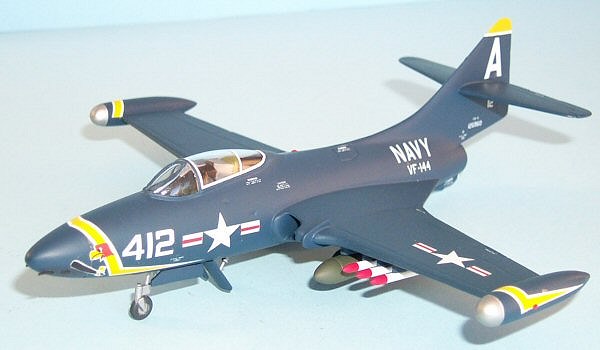
Matchbox 1/72 F9F-4 Panther
|
KIT # |
? |
|
PRICE: |
AUD$ 5.00 |
|
DECALS: |
? options |
|
REVIEWER: |
Michael Johnson |
|
NOTES: |
Used Superscale 72-212 decals |

|
HISTORY |
The F9F-5 was numerically the most important of the Panther variants. It had the longer fuselage and revised tail surfaces of the F9F-4, but was powered by the Pratt & Whitney J48 turbojet, a license-built version of the Rolls-Royce Tay.
The XF9F-5 prototype was the 100th production airframe (F9F-2 BuNo 123085), modified and re-engined. It flew for the first time on December 21, 1949. It actually preceded the XF9F-4 into the air by almost half a year.
616 F9F-5s were delivered to the Navy and Marine Corps between November 1950 and January 1953. They were all powered by the Pratt & Whitney J48-P-6 or P-6A, rated at 7000 lb.s.t. wet.
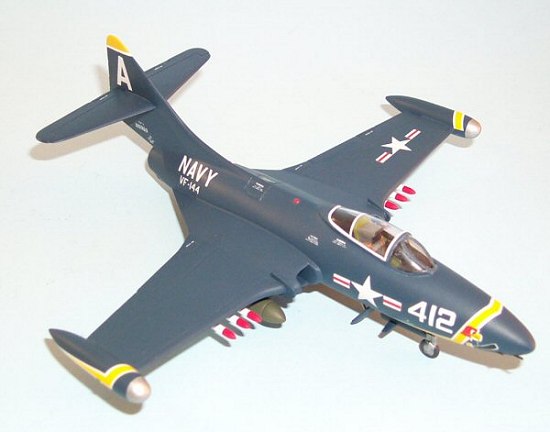 The F9F-5 had four external store pylons
underneath each wing, with the three outboard pylons being stressed to
carry bombs of up to 500 pounds in weight. Maximum external load was 3465
pounds.
The F9F-5 had four external store pylons
underneath each wing, with the three outboard pylons being stressed to
carry bombs of up to 500 pounds in weight. Maximum external load was 3465
pounds.
During the course of production, an anti-stall fence was added just outboard of the wing roots to control the airflow and reduce landing speed. Many of the F9F-4s were retrofitted with J48 engines and thus became indistinguishable from F9F-5s.
The first F9F-5 deliveries took place on November 5, 1950. Most squadrons which had been equipped with F9F-2s were re-equipped with the later F9F-5.
In November 1951, the F9F-5 replaced the F9F-2s of the Blue Angels flight demonstration team. This team began to convert to the swept-wing F9F-6 Cougar in 1953, but it turned out that these Cougars were urgently needed by the fleet for duty in Korea and the team had to be hastily re-equipped with overhauled F9F-5s. The F9F-5s served with the Blue Angels until 1954, when they were finally replaced by F9F-8 Cougars.
The first F9F-5s entered combat in Korea in October of 1952, serving aboard the USS Oriskany (CVA-34) with the reserve squadrons VF-781 and VF-783. They were also flown by VF-51, VF-52, VF-53, VF-111, VF-153, and VF-154 during the latter stages of the Korean War. They provided the backbone of the Navy's carrier-based jet-powered ground attack capability during the last year of the Korean War.
As the Panther began to be replaced in active service by more advanced types, surviving F9F-5s were modified as F9F-5K remotely-controlled drones or as F9F-5KD drone directors. In the F9F-5KD, the nose guns were removed and were replaced by radio control equipment. In 1962, the Defense Department introduced the new Tri-Service designation scheme under which the separate USAF/Navy designations were replaced by a new unified designation system. This required that all existing Navy aircraft be redesignated. By this time, the only Panthers remaining in Navy service were the F9F-5KD drone directors, which were redesignated DF-9E. The last DF-9Es were struck off charge in the mid-1960s.
Specification of the Grumman F9F-5 Panther:
Engine: One Pratt & Whitney J48-P-4/P-6A turbojet rated at 2834kg (6250 lbs) thrust.
Performance:
Maximum speed: 932kph (604mph)
Cruising speed: 774kmh (481 mph)
Initial climb rate: 1551m/min (5090 feet per minute)
Service ceiling: 13,045m (42,800 feet)
Range: 2093km (1300 miles)
Dimensions:
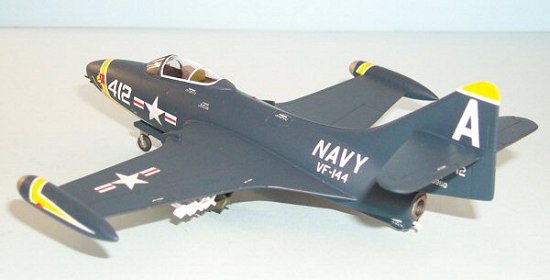 Wingspan: 11.5m (38 feet 0
inches)
Wingspan: 11.5m (38 feet 0
inches)
Length: 11.8m (38 feet 10 1/2 inches)
Height: 3.7m (12 feet 4 inches)
Wing area: 23.2 sq m (250 square feet.)
Weights:
Empty: 4,601kg (10,147 pounds
Gross: 8,057kg (17,766 pounds
Maximum takeoff: 8,490kg (18,721 pounds).
Internal fuel capacity: 1003 US gallons.
Armament: Four 20-mm cannon in the nose. Eight underwing hard points which could accommodate a total underwing load of up to 3465 pounds of bombs and rockets.
Preamble
This was a “must purchase” ebay auction that I stumbled across one Sunday afternoon. With only a few minutes to close, I immediately bid on it and picked up a Gem. When the kit arrived, I could tell it had lived in a shed cupboard for a few years. Plastic inside was good, instructions likewise, but the decals were very poor and unusable.
I decided to build this kit as a partner to my Matchbox Westland Wessex build, leaving the better detailed Hasegawa 1:72 F9F-2 and Eduard PE set for a later date.
An old Microscale sheet 72-212 “F9F-5 Panthers” brought forth from the decal dungeon was an ideal replacement for the kits imploded decals.
|
THE KIT |
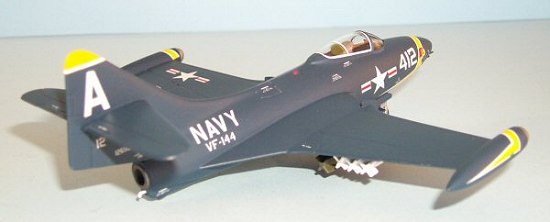 A typical Matchbox side opening box, with dramatic
artwork of a Panther over a Korean War battlefield. The box proclaims
“1:72 in three colours” with the two finishing options printed on the
rear of the box.
A typical Matchbox side opening box, with dramatic
artwork of a Panther over a Korean War battlefield. The box proclaims
“1:72 in three colours” with the two finishing options printed on the
rear of the box.
So what is in the box? There are four sprues within the typical box, one azure blue, one dark blue, one black and a clear sprue for the canopy. The one piece canopy is rather thickly moulded but with nicely defined framing.
The kit allows for the construction of an F9F-4 Panther and a later F9F-5 “Blue Angels” Panther with the inclusion of the wing fences that constitute the main difference between the two versions.
Two decal options are provided, along with an instruction sheet with painting instructions for two aircraft printed on the back of the kit box in typical Matchbox style.
The kit is typical of Matchbox late issues, with fine raised panel lines and heavy moulding to smaller detail parts. Well I was not after a contest winner here at all, so I could safely ignore all the shortcomings built into the kit or otherwise.
|
CONSTRUCTION |
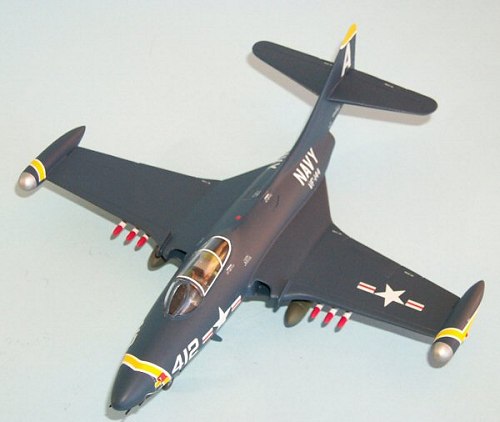 Assembly started with the cockpit, with sidewalls
and tub painted Aeromaster US interior green. The supplied seat was only
a basic representation of the real ejection seat, but with the addition
of Tamiya tape strips to represent harnesses, was more than adequate,
especially as it was only going to be seen under the thick canopy. Side
consoles and the instrument panel were painted black and dry brushed with
light grey to enhance moulded-in detail.
Assembly started with the cockpit, with sidewalls
and tub painted Aeromaster US interior green. The supplied seat was only
a basic representation of the real ejection seat, but with the addition
of Tamiya tape strips to represent harnesses, was more than adequate,
especially as it was only going to be seen under the thick canopy. Side
consoles and the instrument panel were painted black and dry brushed with
light grey to enhance moulded-in detail.
The fuselage is broken up into 4 separated parts, with the main fuselage horizontally split. Dry fitting the completed cockpit tub to the upper fuselage half revealed fit problems with the instrument panel in place, which needed trimming to allow the tub to fit in the correct location.
The kit offers the modeller the choice of lowered or folded wings. I elected to go with the wings down option and used the correct parts for the wings to slot into. Wing assembly was quick with all parts fitting very well indeed. Once the wings had been cleaned up, a quick trip to the paint booth was in order to spray the forward section of the wing tip fuel tanks Tamiya AS-12 BMF. Once the paint was dry, the BMF areas were masked off and the wings attached to the fuselage.
The remainder of assembly proceeded smoothly and rather quickly, with only moderate amounts of filler required to smooth out ill fitting joints. At this point I cleaned up, polished and masked the canopy. The masked canopy was offered up to the fuselage and cemented into place with clear parts cement, reinforced with a careful application of liquid cement; this filled any gaps between the fuselage and the canopy. A quick application of white glue, with excess wiped away with a wet mk1 finger, smoothed out any remaining gaps.
|
COLORS & MARKINGS |
Now that construction was finished I could settle down to painting. I decided to use a spray can of Tamiya USN Sea Blue, .It took 3 coats from the spray can until I was happy with the overall finish, with areas needed re-sanding and polishing with fine wet and dry, to eliminate imperfections. In the end I got close to the result I was after, but not entirely satisfied with!
The painted and completed airframe was put aside to cure prior to application of several thin coats of Johnsons “Super Stride” with a wide flat brush kept especially for this purpose.
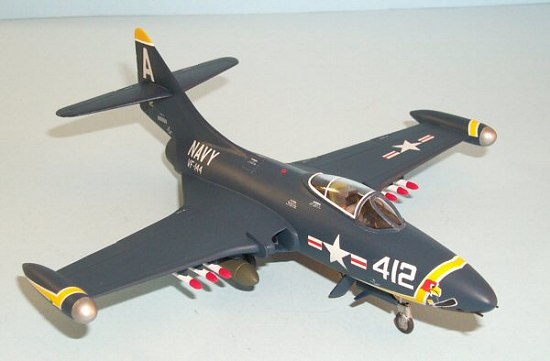 While the fuselage was set aside to cure, I turned
my attention to the underwing stores, consisting of two bombs and 6 HVAR
rockets. I used Vallejo Russian Army Uniform Green as a good match for
the Olive drab finished bombs and appropriate colours for the rockets.
While the fuselage was set aside to cure, I turned
my attention to the underwing stores, consisting of two bombs and 6 HVAR
rockets. I used Vallejo Russian Army Uniform Green as a good match for
the Olive drab finished bombs and appropriate colours for the rockets.
The decals turned out to be a really big problem.
As mentioned earlier, the kit decals were useless having been attacked by moisture during their long tenure in the box so I decided to use an old Microscale sheet 72-212 “F9F-5 Panthers”. I selected one of the four schemes from the sheet, a Panther from VF-144 serving on USS Boxer during 1955.
I started off with a small stencil to test the decal; this went on fine so I proceeded with the large “A” on the tail. This decal promptly shattered upon hitting the water, which was very annoying as the test decal indicated that all was well with the sheet. A quick search found replacement “A’s” from a Superscale Banshee sheet. Upon hitting the water the first “A” from the Banshee sheet shattered as well. (I never learn!), so Microscale’s Decal Film came into play and I spent time painting this wonderful product over the required decals so I could continue using the sheet. Decaling proceeded more or less trouble free after that.
Everything was then sealed in with several more coats of Future resulting in a nice shiny looking Panther, which had the shine taken back with a coat of Pollyscale satin clear. I was hoping that this was going to give a good “scale” representation of the Panther’s glossy sea blue scheme but the model looked very toy like. Research indicated that the gloss sea blue varied from really glossy to a more weather-beaten appearance, almost flat in finish. Armed with this knowledge, I resprayed the model with Pollyscale flat clear which gave the model a more “in-scale” look.
Lessons learnt from this experience were;
|
FINAL CONSTRUCTION |
 I added new, stretched tube 20mm cannons to the
nose, and touched them over in appropriate colours. Once these had set,
the canopy masking was removed; the pre-painted undercarriage airbrakes
and arrestor hook were added. I left the model overnight to allow the
undercarriage assembly to cure, and then added the underwing load-out.
I added new, stretched tube 20mm cannons to the
nose, and touched them over in appropriate colours. Once these had set,
the canopy masking was removed; the pre-painted undercarriage airbrakes
and arrestor hook were added. I left the model overnight to allow the
undercarriage assembly to cure, and then added the underwing load-out.
Some light weathering with pastel chalks followed, concentrating on the nose cannons and undercarriage bays.
Suddenly the Panther was finished.
|
CONCLUSIONS |
What a great little kit! The Matchbox F9F-4 Panther is an excellent build between more complex projects and builds up into a fine replica of a mid production Panther, the US Navy’s second jet fighter. As the Matchbox kit has been out of production now for a number of years, the only 1:72 Panther available is the most excellent F9F-2 version from Hasegawa.
The big bonus from this Matchbox kit is the ability to model it with wings folded, without complicated surgery. Squadron/Signal’s “F9F Panther in action” has a series of wing fold close ups, so one day perhaps if another Matchbox kit is sourced!
If you can get hold of this kit, grab it and enjoy the build. Recommended!
August 2004
|
REFERENCES |
Copyright Modeling Madness.com. All rights reserved. No reproduction in part or in whole without express permission.
If you would like your product reviewed fairly and fairly quickly, please contact the editor or see other details in the Note to Contributors.